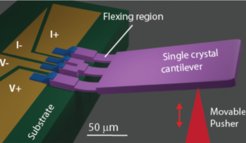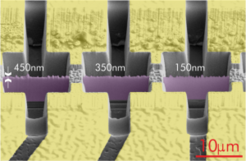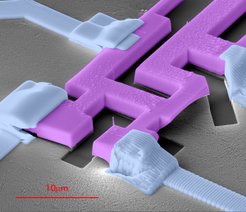Research
Extreme bending strain

Likely the most important breakthrough in our understanding of metals was Bloch’s theorem. Exploiting the translational invariance of a crystal severely constrains the quantum mechanical problem, which allows us to find tangible solutions of the energy spectrum of a metal. Even in exotic phases of matter, for example in highly correlated electronic metals, this concept persists and the symmetries of a crystal remain as our guiding principles. In the project XBEND, funded by the ERC in 2023, we explore how quantum materials react when they are freed from these symmetry constraints. We will introduce controlled strain gradients into crystals that explicitly break translational invariance, and study their response. A focus point falls onto unconventional and high-Tc superconductors, in which new states are proposed to exist if gradients can be made sufficiently strong.

The crux of this problem is highly technical, at the forefront of current nanofabrication. Obtaining gradients is easy, but obtaining controlled gradients at meaningful strength is a challenge. We employ focused ion beam micromachining to carve flexible micro- and nano-structures from single crystals, and integrate them into electro-mechanical hybrid chips that allow electrical testing under extreme deformations. This research pushes our boundaries, both in terms of our conceptual understanding of matter as well as in our ability to control complex shapes in 3D.
Correlated order in Kagome metals

The 2D Kagome lattice has been a rich testbed for various quantum phenomenon. In the late 1980s it was shown that the antiferromagnetic kagome lattice may be the most frustrated two-dimensional (2D) magnetic system that one can construct. Ever since it is always considered as the prime candidate of realizing a novel quantum state called quantum spin liquid which is generally characterized by the long-range quantum entanglement and fractionalized excitations.
More recently it has been realized that a 2D Kagome net may host topological nodes coexisting with non-dispersing electronic band. Therefore, metals hosting Kagome nets have become a fruitful avenue to explore correlated topological materials. Their orbital and magnetic frustration generically leads to the topological Dirac nodes in the presence of strong electronic correlations, which are associated with non-trivial behavior such as giant intrinsic anomalous Hall effect and topologically protected boundary states.
An intriguing example of electronic instabilities on a Kagome lattice driven by strong correlations is the AV3Sb5 (A = K, Rb, Cs) family of kagome superconductors. These materials display the formation of an unconventional chiral charge order featuring a tantalizing charge modulation and therefore present a fantastic sandbox to probe correlated quantum phenomena. This includes the first example of switchable electronic chirality, giving the future electronics a rewindable twist.
Topological metals

In the recent years, materials with non-trivial band topology have attracted significant interest in the physics community. These materials host band-crossings that are required to appear because of their topological invariants, and are thus stable against disturbances such as strain, defects, etc. which commonly open a gap in such degenerate systems. The low-energy physics of such a band-crossing can be linearized, and thus mapped onto the equations describing massless relativistic fermions, the Dirac (or Weyl) equation. Therefore the quasiparticles in these materials behave similar to elusive mass-less fermions that so-far are unobserved as elementary particles.

The solid does not only emulate the dispersion of these relativistic particles, but also new physics emerges that inherently does not exist in elementary particles: Unlike the boundless universe, the solid has a surface where the medium that hosts this relativistic dispersion terminates. At this surface, the crystal translational symmetry protecting the relativistic dispersion and the conserved quantum numbers such as particle chirality are broken, and new states must appear at the surface. These topologically protected surface states have unique properties such as robusness against defects, which also renders them interesting for electronic applications.

To study these surface states on topological semi-metals in transport experiments, a large surface-to-bulk ratio is essential as one may expect the bulk conductive states to completely mask any signatures of the surface states. To achieve such large surface ratios, we pioneer the fabrication of microstructures of Dirac semi-metals such as Cd3As2 and Weyl semi-metals such as the monoarsenides (e.g. NbAs). We study these materials on the 100nm length scale, which is the length scale of potential industrial applications. At these length scales, the topological surface transport is found to be a sizable contribution to the current flow in these microdevices. In addition, we recently found evidence for quantum coherence developing between the Fermi arc states on opposite surfaces when the device dimension become smaller than the mean free path, which sets the relevant length scale in these materials.

Moreover, in solids there also exist topological defects beyond the mimic of elementary particles. This includes the triplet degenerate fermions realized in non-symmorphic crystalline structures and the multifold fermions which feature band crossings beyond 4-fold degeneracy. For all these different types of topological materials, the crystalline symmetry has always been the guiding principle to effectively explore and categorize them. We introduced an alternative guiding principle, which we call ‘quasi-symmetry’. This is the situation where a Hamiltonian has an exact symmetry at lower-order that is broken by higher-order perturbation terms. This enforces finite but parametrically small gaps at some low-symmetry points in momentum space. Untethered from the restraints of symmetry, quasi-symmetries eliminate the need for fine-tuning as they enforce that sources of large Berry curvature will occur at arbitrary chemical potentials. This giant Berry curvature acts as a non-trivial source of anomalous velocity for the electronic wave-packet, which can lead to exotic quantum transport properties such as spontaneous Hall effect without applying magnetic field.
High-Temperature superconductivity

High-temperature superconductivity is one of the most fascinating phenomena arising from strong electronic correlations. At temperatures up to 165K in copper-oxide superconductors, unconventional Cooper pairing resists strong thermal fluctuations and maintains a macroscopic coherent quantum condensate at half of room temperature. The still unsolved case of high-Tc superconductivity has gained significant momentum through recent breakthrough discoveries such as the observation of superconductivity up to 56K in iron-based superconductors, the identification of the Fermi-liquid ground state through quantum oscillations in cuprates as well as the experimental confirmation of charge-density-wave type correlations coexisting with the dome of high-Tc.

Such rich phase diagrams of intertwined orders such as nematic/structural/spin-density in the iron-based materials or the charge-density wave/anti-ferromagnetism/pseudogap that coexist or compete with superconductivity pose natural questions to be addressed by experiments on the micron-scale. These various order parameters exhibit distinct physical length scales, and size-dependent measurements on the sub-micron scale thus provide a pathway to separating these individual phases and study them in single-domain states. In addition, many materials classes such as the LaFeAsO-family of pnictides can thus far only be synthezised in single crystals on the 100 micron scale, which renders even essential basic measurements such as transport anisotropy impossible without the micro-fabrication techniques we advance.
We are also particularly interested in the application potential of these materials for next-generation high-field magnets and lossless power transport. Using our FIB approach, we can establish the important technical parameters such as upper critical field, vortex pinning and critical currents even on micron-sized particles which are typical products of first growth attempts of newly discovered materials. Without the delay in research caused by the need to grow large scale single crystals, we collaborate with materials synthesis experts in the search for those materials with optimal properties for wire fabrication.
Heavy fermion in quantum technology
Max Planck famously said “insight must precede application”, formulating a feeling at the time which later turned into a societal divide between basic and applied physical sciences. Curiosity-driven basic research aims at our fundamental understanding of the working principles of nature, and often practical applications are beyond imagination. However, as technology progresses, its needs venture into what was previously thought to be of purely academic research. A famous example is general relativity, born out of space-time considerations which became the key to satellite-based technologies such as GPS.

Here, we revisit heavy fermion metals, in which the duality between localization and delocalization of 4f/5f electrons leads to strong electronic interactions. This mature field was a drosophila of our understanding of quantum criticality and its relation to unconventional superconductivity. At the same time, technology progresses, and the changing materials needs of a transition to quantum-coherent technologies suddenly catapult Tc~1K superconductors into the spotlight of technologically relevant materials. After all, aluminum is a serious platform for superconducting qubits despite its Tc~1.2K. As part of a global collaboration, we now explore if and how the unique physical properties of heavy fermion systems can find applications in technology. Building and characterizing the first qubits from heavy-fermion superconductors will be the first ongoing step of this effort. It will be exciting to see if indeed insights preceed applications in this field.









